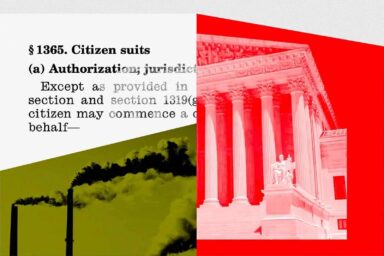There’s a dearth of information on the health of lakes in marginalized communities.
|
Listen To This Story
|
Flooding has become a common occurrence in the East Houston neighborhood where ecologist Jessica Díaz Vázquez grew up. When the water rises, she and other residents of this predominantly Latinx community wonder whether pollutants from nearby petrochemical plants are coming with it.
“You don’t want to go near [the water] because you really just don’t know what could be in it,” said Vázquez, who is now a fellow at NOAA.
“If we’re truly trying to move towards an environmentally just society … we need those data.”
Hers isn’t the only community wondering what’s in its water. According to a new study published in Frontiers in Ecology and the Environment, lakes in communities where more than a quarter of residents are Hispanic or people of color are three times less likely to have been monitored for water quality than lakes in predominantly white, non-Hispanic areas of the United States.
That’s a big problem, because “if we’re truly trying to move towards an environmentally just society … we need those data,” said environmental justice scientist Rae Cade from Montclair State University.
Deep Disparity
As an undergraduate student at Michigan State University, Vázquez hoped to analyze whether the racial and ethnic makeup of communities was related to the quality of nearby water. “We couldn’t get to that,” Vázquez said. Instead, she and her colleagues found that data from marginalized communities often don’t exist.
To demonstrate this disparity, Vázquez and her colleagues combined census data with information on water quality that they gathered from the National Water Quality Monitoring Council.
The researchers focused on lakes and found that marginalized communities often lack access to these bodies of water to begin with. Only 18 percent of lakes are located within census block groups where at least a quarter of the residents are people of color (POC), and 5 percent are within block groups where at least a quarter of the residents are Hispanic.
And in these lakes, monitoring is often rare. Only 7.5 percent of all lakes that have been monitored in the country are within POC communities, and 1.7 percent are in Hispanic communities. On the occasions when these lakes are monitored, sampling is usually less frequent and records are not as long as in predominantly white, non-Hispanic communities.
The southeastern United States is the only exception. Here, 7 percent of lakes in Hispanic communities have been monitored versus 6 percent in non-Hispanic communities.
Pushed Aside
“I don’t think there’s just one reason” for the dearth of data on these lakes, Cade said. Sometimes money is likely the limiting factor, and other times it could be something as simple as the fact that public transit does not always serve marginalized communities well, so the lakes within them aren’t easily accessible to the people who might monitor them.
Cade has seen through her research that uncertainty over water quality leaves people with a sense of unease. “It can weigh on people,” she said.
“It adds to this feeling of being attacked by your environment.”
“It adds to this feeling of being attacked by your environment,” said sociologist Stephen Gasteyer, drawing on his experience with people living along the extremely polluted Calumet River on the outskirts of Chicago. Gasteyer is also at Michigan State University but was not involved in this research.
American society has a long history of racism that continues to push marginalized communities into less desirable neighborhoods, said policy analyst Nambi Ndugga from the health policy research, polling, and news organization KFF. Green space is often lacking in these neighborhoods, and she’s not surprised to see the new study’s findings extended to blue space.
It would be interesting to examine why lakes in Hispanic and POC communities become neglected, Gasteyer said. Lack of financial resources may not always be the direct cause. Gasteyer recalled a time when a student of his was asked to test the water quality of a lake within a wealthy gated community, only to find that “no one had the time to show up at a community meeting, much less to decide that [the health of the lake] was a communal problem,” he said. Similarly, people living in marginalized communities may work long hours, which may make it hard for them to find time to collaborate on this kind of effort.
This story by Saima May Sidik was originally published by Eos Magazine and is part of Covering Climate Now, a global journalism collaboration strengthening coverage of the climate story.





